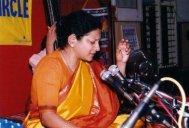
|
 |

|
 |
Creation and Silences - Kala Ramesh, Pune e-mail: nonesuch@vsnl.net January 6, 2005 |
|
Tao says:
Shabda. Maun. Shoonyata. In the context of Indian Shastriya Sangeet, these are big and weighty words. If we look at it from the surface, ‘maun' is silence. But maun in music is more than mere silence; it is a pregnant silence! Born out of that silence is Music. According to the shastras, Omkara dhvani was the first primordial sound that permeated the universe. In Goenkaji‘s Vipashana Centers, you see placards with the words ‘arya maun' and below that in English it says ‘noble silence'. A silence is noble when it comes out of an egoless state? May be? So the next logical conclusion is to say that silence is closest to a perfect state when it is noble. Silences have various avatars, like that deadly silence when murder is committed or when we are shocked, so on and so forth, but silence in music has its own flavour, a rasa. It stands apart. Now why is silence so important in music? Without silences, music means sounds coming from a non-stop chattering mind and that even from the best of musical minds can get tiring! That ‘break' is so necessary, for they say that the mind's attention span is just 40 seconds. That reminds me of a beautiful belief that the late Pandit Kumar Gandharva used to hold close to his heart. He was supposed to have said that, when a bandish has a beautiful finishing line, it should be sung only once. Never to repeat that line again. For, in all probability the rasika's wandering, chattering mind would have missed it! And sure enough you have this listener's undivided attention now for quite some time, without doubt! Silence is golden; we have all heard that line. Most often than not, silence conveys more than the music itself for ultimately the ‘unknown' is beyond words. Even the best of musicians have to accept that is it SILENCE that elevates their music to greater heights. Now let me explain this in a different way to make myself clear. In Hindu philosophy, we explain the ‘unknown' in various ways. The crescent moon or the waxing moon on the third day is very important to the Hindus. And generally in our homes when we were kids, our elders would try to point out that almost non-existent moon to us! This is how it would go! You see that low branch over there in that mango tree? You see that fork in that branch? See that leaf in the corner, at the tip? Yes? By now we would be all excited like we were on a mystery trail or something. Now between that leaf and the other leaf from the other branch you see the sky? Yes! We would cry in chorus! Now look straight ahead into the night sky, do you see that thin white line? There would be great excitement. Yes, we have ‘discovered' the new moon. The adult can lead the child only to that last leaf, after that, the child needs to take that LEAP into space to find the moon! The voice cannot carry the tongue and the lips that gave it wings. Alone must it seek the ether, said Kahlil Gibran most poetically. Divine music and dance has to enable us to have a taste of that which is ‘sacred'. But humans with our imperfections can never do that. All the great artists, be it in music, dance or in any other art form take the rasika figuratively by the hand and lead him towards the ‘unknown'. But there is that vast expanse of ‘space' between the human effort and the Unknown? In music, this space; this short gap in time is Silence. Arya Maun. When, Time stands still. Is it this SILENCE that makes music divine? The deep silences, the pregnant silences. And, behind this silence? Void. Shoonyata. Creative Energy. The seers say that to go beyond time and space is Mukti (liberation) What are the Sapta Swaras? Have you ever wondered? Your aadhara swara might be different from my aadhara swara. Your sapta swara, the whole scale, the full octave is built on your base note ‘shadja' out of thin air! You give it a concrete shape and give a form, a roop to call it a raga. This whole creation has come out of that “great sacred void'' and it needs to return to its source. And this is what Silence does in a silent way to music. This is why those half pauses, full pauses or being completely enveloped by that over powering silence for sometime is so essential in a music recital. This adds vitality and poignancy to the Art. The greatness of a musician is evident when this silence does not seem contrived but is the natural and simple sequence to his thought process. All great Art is simple. It seems simple. From clay, the pot emerges and to clay, it returns. 
Kala Ramesh is a performing vocalist in Hindustani Classical Music, who has worked on Pandit Kumar Gandharava's compositions along with the paramparic bandishes of the Gwalior Gharana. Kala has several articles published on Shastriya Sangeet and Indian thought to her credit. |